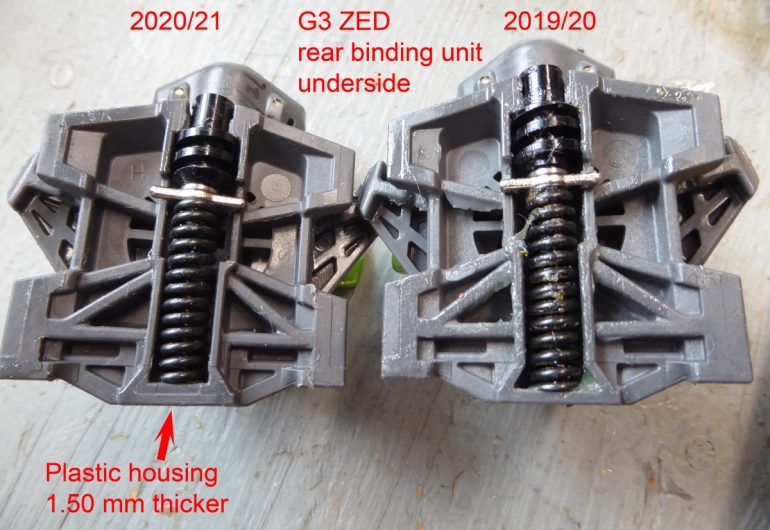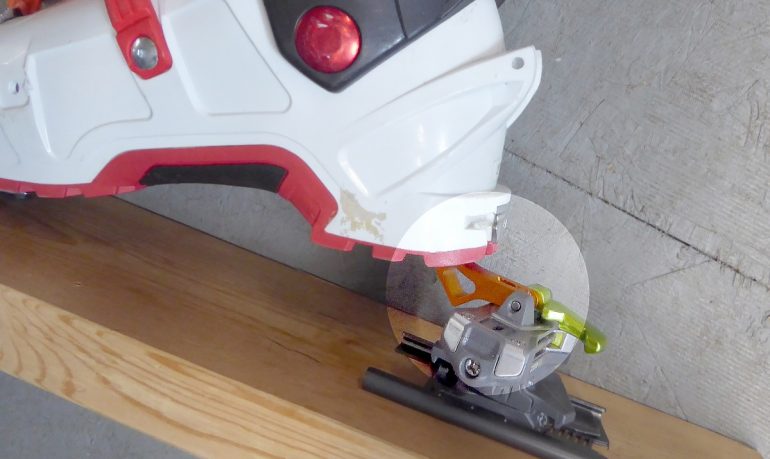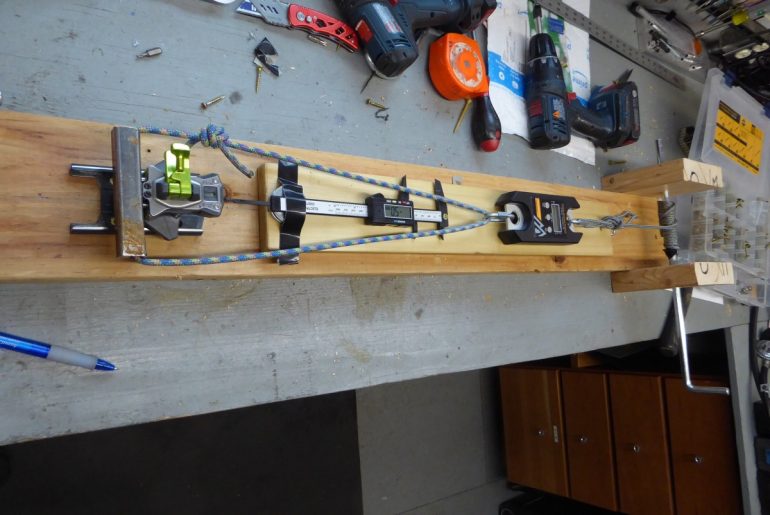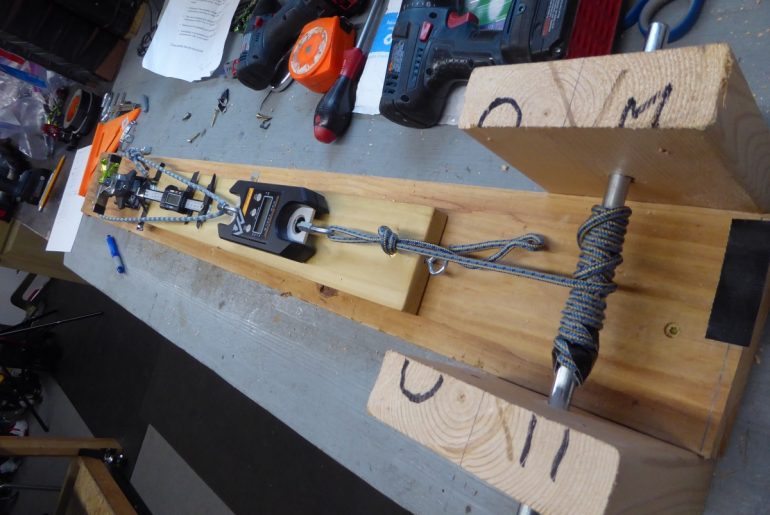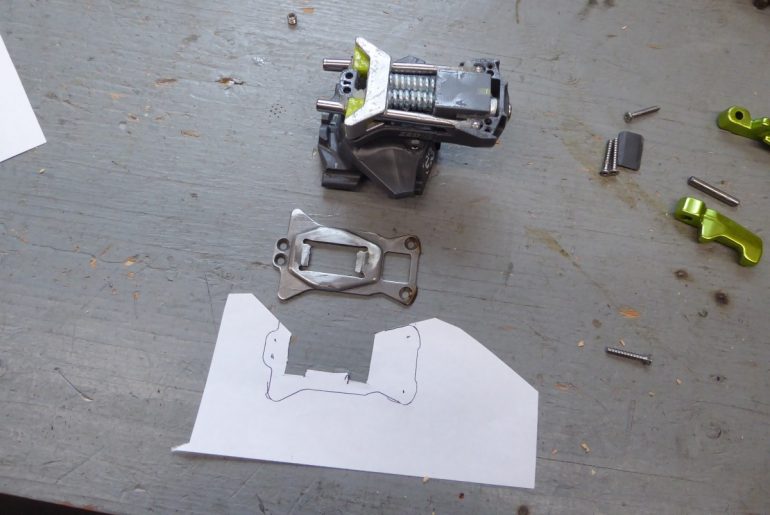Hi all. After we published the post below, G3 was kind enough to send us an updated ZED heel unit, due for distribution fall of 2020. The unit is nearly identical, with one possibly key change. They thickened the housing on one end of the spring, by 1.5 millimeters. This preloads the spring, and makes an easily tested/verified difference in spring rate. Along with that, G3 reduced the flex compensation travel distance ~2.8 mm, from ~9.6 mm to ~6.8 mm. In theory, both these changes will reduce the likelihood of annoying heel unit movement while in touring mode (see video near bottom of post.) Moreover, I suspect the new spring might be a bit stiffer, but additional pre-loading, compared to previous configuration, might be the more important operative mechanism here.
So, how did the spring rate measure out in comparison to the 2019/20 version of the ZED heel? Check our spreadsheet windowed below. In summary: 19/20 averages ~67.6, while 20/21 averages ~94.3. That’s a ~72% increase! Will this fix the problem some skiers have with this shifting/movement? Read on.
In our original blog post below, we determined that the geometry of the heel lifter is likely the primary cause of the heel unit movement. But a stiffer spring will no doubt help. SO I TESTED. The 19/20 version moved in my opinion all too easily, even with my below average body weight and no backpack. The 20/21 version moves as well, but MUCH LESS EASILY (and with less maximum possible distance). Movement was imperceptible when I made a normal, simulated stride. If I stomped my heel down somewhat gently, still no obvious movement. When I came down hard, movement.
CONCLUSION: I think this new version will be fine for anyone on the lighter side of the body weight curve, while brutes should demo the binding before committing. Beyond that, I wish G3 had at least somewhat changed the shape of the heel lifters. Perhaps that’ll still happen, they’re easy to swap out. For proof of concept see the following experimental mod, as well as another mod near the bottom of this post:
Important note regarding the ZED changes. Any aficionado of tech bindings will find it ironic that the ZED travel, created by a complex spring and housing configuration, is now 6.8 millimeters. Why? The original tech binding design provided ski flex compensation by providing a gap between the boot heel and binding, along with allowing the boot heel fittings to slide fore/aft on the binding heel pins. We’ve come to call this the “tech gap.” Some tech gaps were about 6 millimeters, and binding/boot combo could easily be built to that, or in my opinion a few millimeters more. Granted, a smooth, reliable spring such as that of the ZED, many other touring bindings, and all alpine bindings, is the standard of ski binding engineering. But one wonders (as I ruminate on below as well), why not just provide an old style tech gap and be done with it? The answer to that question involves everything from product liability to ISO/DIN politics. Another blog post? We shall see.
ORIGINAL POST BELOW
Someone asked for it. I geeked out. At least that’s the vague recollection sifting through the maze of load cells and digital calipers here in the Wildsnow skunk works.
It began with G3, as some skiers experience an annoying rearward shifting in the ZED heel unit when they tour, due to the flex compensation spring compressing (perhaps combined with the shape of the heel lifters, and boot sole). The theory bandied about: “G3 spring is softer than normal.” A theory. Time to measure things, test, and develop a data-supported opinion about what’s going on.
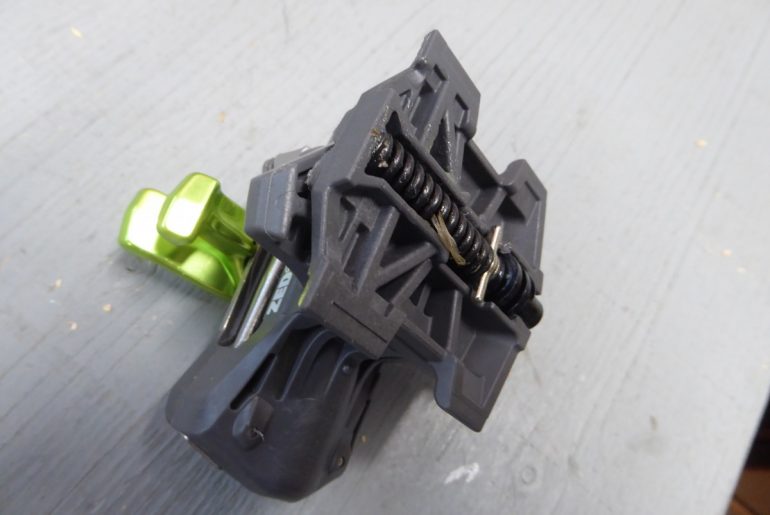
Underside of G3 ZED, showing flex compensation spring. For those of you who’ve lived in a snowcave for the past twelve years, know that any ski binding has to somehow allow for ski flex shortening the distance between the heel and toe units of the binding. The simplest tech bindings accomplish this with an air gap (tech gap) behind the boot heel. Other, more complex bindings, including alpine bindings, place the heel unit on a track, with a spring that allows movement while keeping the heel unit in position.
At first, I planned a simple yank on the bindings and through a process of gut feeling, or perhaps a load cell, gain a sense of the force required to compress the flex compensation spring. That seemed crude — the kind of thing that would get me some something along the lines of a hockey puck to the face from certain Canadian individuals. So I researched the basic calculation for “spring rate,” which is how the “stiffness” of a spring is expressed as a number. Using my trusty desktop box of silicon and copper, I found a basic formula for spring rate, really basic, just force divided by distance, providing a number that allows comparison between different springs.
Using a chunk of 2×6 inch framing lumber as a foundation, I constructed a windlass — an incredibly sophisticated force application tool first observed in paintings on walls inside the Great Pyramid (or so I’d heard from my grade school history teacher).
A digital caliper provided the throw/distance instrument. To finish, I slung a load cell (force gauge) on Spectra cord, and drilled a pair of holes in a steel bar that sits over the heel pins, attached to the load cell and windlass. (In one case, ION LT, I rigged things differently because the ION spring behavior changes when in touring mode.)
Using the test rig is simple. I mount a binding, sling it to the load cell, zero out all instruments, then give a smooth careful tug. I kept my pull distance at around 2.5 mm, figuring there might an error compounding if I was jerking things like a beat puppet.
The measured results were gratifying, and matched the “feel” of each unit I got when I spun the windlass handle. Check out the numbers below, but first note that the G3 binding models vary quite a bit in how the spring behaves. As with most tech bindings, switching the ZED to touring mode doesn’t change the spring. However, the ION LT (and other IONs) features an ingenious spring compression feature — the spring becomes stiffer in touring mode, with travel significantly reduced. (Incidentally, testing the ION was difficult, because of its limited throw and curvy surfaces not accepting my movement gauge caliper, but it does have a tiny bit of throw even in touring mode, and I got what I believe are valid numbers.)
Next: What causes the Zed’s bouncy heel unit?
As alluded to above, common wisdom regarding ZED is “the spring is too soft.” My testing does show the ZED spring falling on gooey side of reality, at 67.7, but the Dynafit Rotation clocked softer at 63.11, and the Fritschi Xenic wasn’t much stiffer at 76.21. Compare those to the Marker Alpinist at 124.9, or the hardest of them all, ION LT at 192.5 (again, tested while configured with ingenious feature which pre-loads the spring when you rotate the heel to touring mode).
Ok, in other words, some other bindings have soft springs as well, but don’t experience the amount of movement we’ve seen with ZED. There has to be something else going on. In my opinion the answer is simple: The medium height ZED heel lifter is slanted down towards the front of the ski — the boot heel forces it rearward. Check the images below, and our video of the problem.
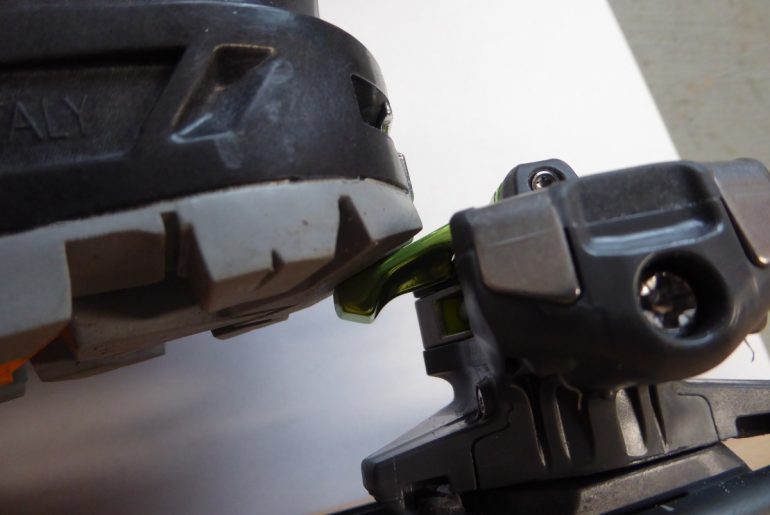
ZED with Scarpa Maestrale on medium height heel lifter. Notice how the lifter forms an inclined plane. Combined with water for lubrication and the rocker bevel at the heel of many boots, it doesn’t take much weight to generate force that displaces the binding rearward.
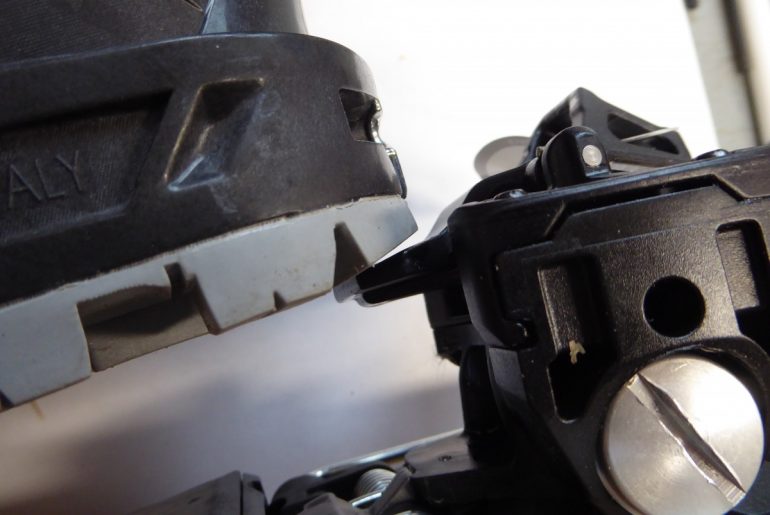
Dynafit Rotation also has a soft spring. Notice how the heel lifter forms a more level shelf. It also has small teeth on it to reduce keep the boot heel from sliding. In my testing, I couldn’t get the Dynafit binding to move, and I’ve not heard of any problems. That said, I’m certain ANY tech binding with a compensation spring could or will move a bit in touring mode. A millimeter or so is probably acceptable.
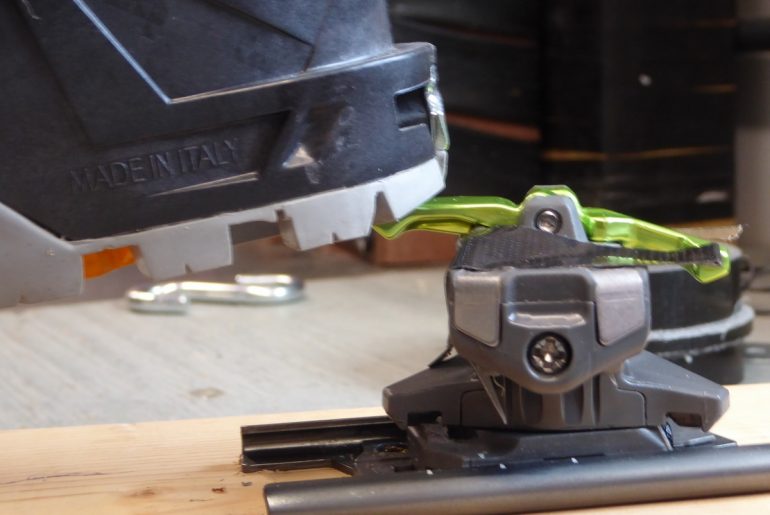
So… upon observing this behavior I did a simple eliminator test. I shimmed up the medium-height heel lifter to near level (parallel to ski), and again weighted the boot with body weight. Yes. This simple change eliminated all but about two millimeters of rearward shift! There you go. Of course this test makes the medium lifter quite high. So I’m not sure how much it applies to a real-world solution. But it 100% proves that the shape of the lifter is most of the problem (while the softer spring clearly contributes).
CONCLUSION
Overall, this has been a fun project for us. It’s no secret I’m a huge fan of G3 bindings (though I prefer those without brakes, another story). These guys don’t hesitate to innovate, and they stay on top of any problems. The thing about ZED is not everyone reports this heel-movement behavior. I suspect that has to do with a number of factors, perhaps lighter weight skiers, perhaps different boot sole shapes. In any case rumor has it a stronger spring is available for the ZED. Will that make the binding quieter? Stay tuned. And in the meantime, if you want G3, I recommend the ION LT (best toe unit in the biz, IMHO), with my preference of no brakes.
TEST SOLUTION
Give me some spare parts, a disk grinder and a half hour.
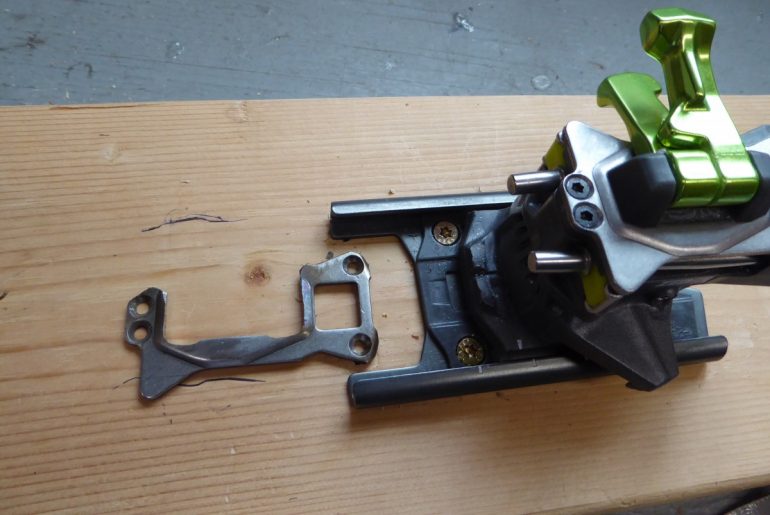
Sculpting complete, shim plate ready for installation. It layers on top of the existing plate, using the same screws (or longer screws if real life).
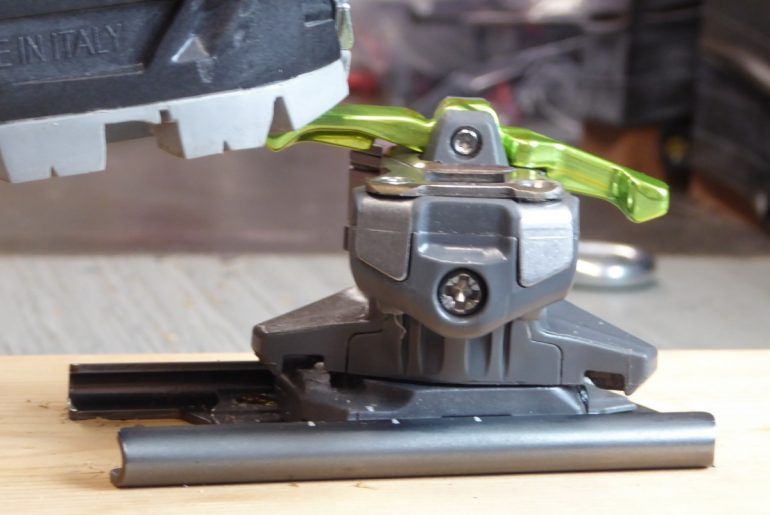
Shim plate installed (not a real life solution, just an illustration). If one wanted a “real” soulution, the best bet might be removing the top plate, adding an attached shim just under the heel lifter, then re-installing the plate. The shim could be a small piece of 1/8 inch aluminum stock, epoxied and/or riveted to the ZED top-plate. Could be a fun project.
NOTES
– All bindings flex and bend quite a bit, this increases the travel available for flex compensation. Though ask too much of this and bam, breakage.
– Let us all hail the original tech binding design, which did not have a ski flex compensation spring. But instead depended on a ~5 mm “tech” gap at the heel, along with binding and boot flex. So simple. So elegant. Can we go back to those days? Please?
WildSnow.com publisher emeritus and founder Lou (Louis Dawson) has a 50+ years career in climbing, backcountry skiing and ski mountaineering. He was the first person in history to ski down all 54 Colorado 14,000-foot peaks, has authored numerous books about about backcountry skiing, and has skied from the summit of Denali in Alaska, North America’s highest mountain.

